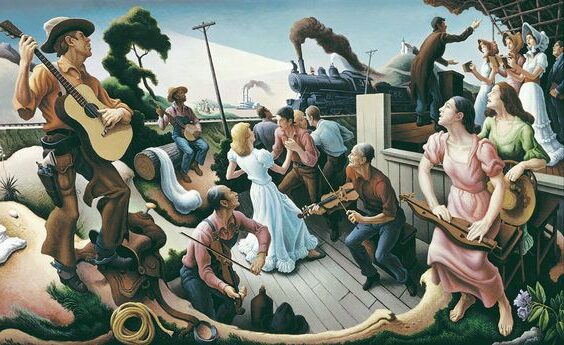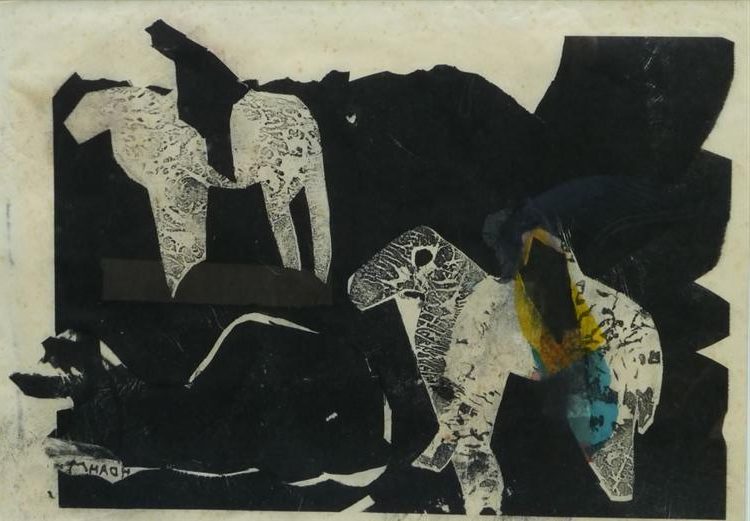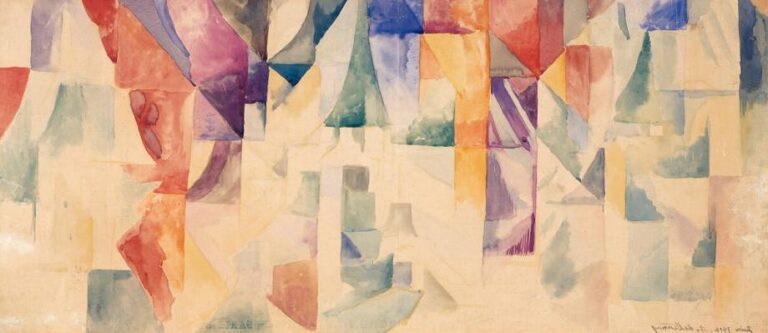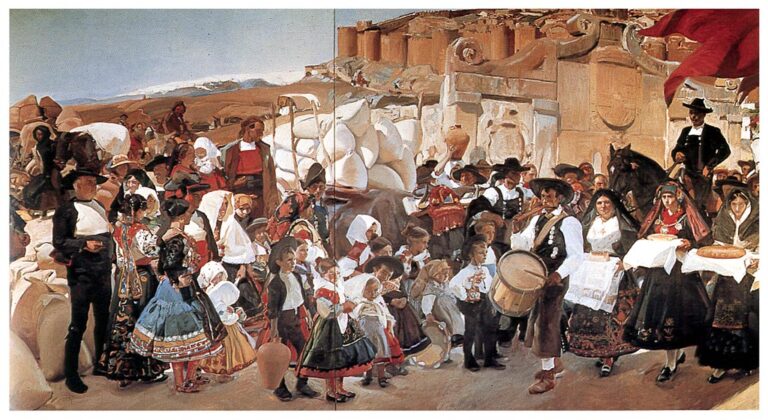Thomas Hart Benton Paintings: Exploring American Regionalism Masterpieces
Born: April 15, 1889; Neosho, Missouri, United States
Death: January 19, 1975; Martha’s Vineyard , United States
Art Movement: Regionalism, Synchromism
Nationality: American
Influenced By: Jackson Pollock, James Lesesne Wells, Lewis Hine
Institution: The School of The Art Institute of Chicago and Académie Julian
Thomas Hart Benton Paintings: Exploring American Regionalism Masterpieces
Thomas Hart Benton’s Life and Career
Thomas Hart Benton was an influential American artist whose work embodies the spirit of Regionalism. His journey from Neosho, Missouri, to becoming a renowned painter has carved a unique place for him in American art history.
Early Years and Education
Thomas Hart Benton was born in Neosho, Missouri, in 1889 into a family with deep political roots. His father, a congressman, aimed for him to pursue a political career, but Benton discovered his artistic passion early on.
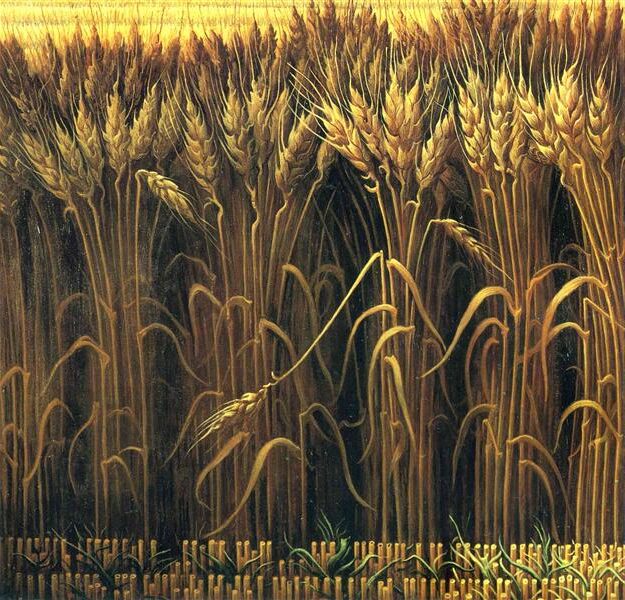
Wheat (1967) by Thomas Hart Benton
He attended the Art Institute of Chicago, where his interest in art deepened. Later, Benton moved to Paris to study at the Académie Julian, immersing himself in the vibrant art scene.
In Paris, he gained exposure to modern art movements, significantly shaping his artistic approach. Returning to America, Benton incorporated these influences while focusing on uniquely American themes.
Rise to Prominence
Benton’s move to New York City played a significant role in his rise. He became a leading figure in the American Regionalism movement, alongside contemporaries like Grant Wood and John Steuart Curry.
His work captured the essence of American life through paintings that highlighted everyday scenes in the Midwest and the South. Murals like America Today showcased his unique style, characterized by fluid, dynamic figures. By the 1930s, Benton had gained national recognition, cementing his status as a key figure in American art.
Later Years and Legacy
In his later years, Benton settled in Kansas City, Missouri, where he continued to produce art until his death in 1975. He taught at the Kansas City Art Institute, influencing a new generation of artists.
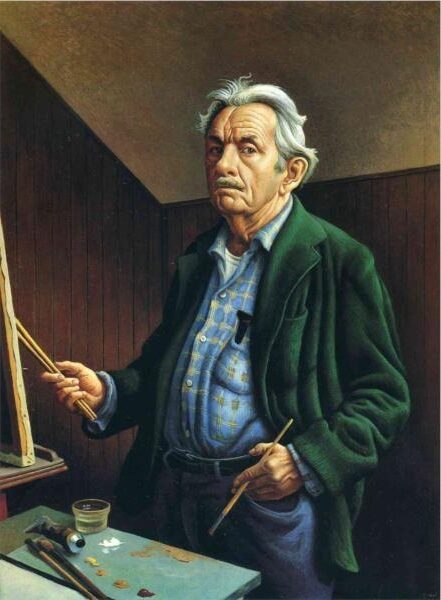

His legacy lives on through his impactful works and contributions to American art. Benton’s commitment to portraying the American experience established him as a pioneering force in art. His self-portrait and other artworks are celebrated for their vivid depictions and storytelling, leaving a lasting imprint on the art world.
His innovative approach and dedication to art have ensured his place in history as a celebrated American painter and Regionalist.
Artistic Style and Influences
Thomas Hart Benton played a key role in the development of the Regionalist Art Movement. He explored different art styles, including Synchromism, to depict American life. Influences from artists like Diego Rivera and John Steuart Curry enriched his work, while his teaching impacted the careers of artists like Jackson Pollock.
Development of Regionalism
Benton was a leading figure in Regionalist art, focusing on themes of everyday life and landscapes of the American Midwest and South. His art depicted farmers, workers, and rural scenes, resonating with people looking for an art that felt distinctly American during the 1930s.

Trail Riders (1964–1965) by Thomas Hart Benton
He collaborated with contemporaries like John Steuart Curry and Grant Wood, driving the movement that emphasized realism and narrative. The Regionalist style sought to celebrate local life and resisted the growing influence of European modernism, making it accessible and meaningful to a broad audience.
Synchromism and Modern Art
Before committing to Regionalism, Benton experimented with Synchromism. This artistic movement, developed by Stanton Macdonald-Wright and Morgan Russell, focused on color theory and abstract forms.
Benton adopted its ideas, using vibrant colors and dynamic compositions to give movement to his figures and scenes. While Synchromism itself did not have a lasting impact on his career, it helped refine his use of color and structure.
Benton’s capacity to blend different techniques demonstrated his adaptability and contributed to his unique style.
Influences and Contemporaries
Benton drew inspiration from various artists and movements. The monumental murals of Diego Rivera influenced his approach to large-scale works. His interactions with younger artists, including Jackson Pollock, were noteworthy.

Spring Tryout (1946) by Thomas Hart Benton
At the Art Institute of Chicago, Benton embraced dynamic forms and movement, integrating these into his storytelling. His close relationships with fellow Regionalists John Steuart Curry and Grant Wood provided fruitful exchanges of ideas and kept him rooted in the American narrative.
Though his style remained largely distinct from the emerging Abstract Expressionism, Benton’s work laid the groundwork for artists exploring uniquely American themes and forms.
Notable Works and Themes
Thomas Hart Benton, a key artist in the Regionalist movement, created many notable works that reflect American life, especially in the Midwest and South. His art included murals, iconic paintings, and other forms like lithographs and drawings.
Famous Murals and Public Commissions
Benton’s murals were significant in shaping American public art. His piece, “America Today”, is a well-known mural series that captures scenes of American industry and culture during the Great Depression.
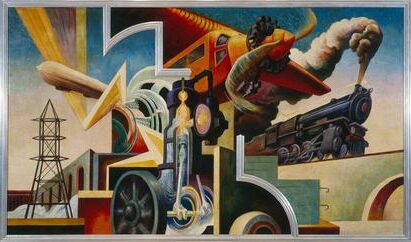
America Today (1930–31) by Thomas Hart Benton
Located at the New School for Social Research in New York, it stands as a powerful depiction of the era.
Benton also contributed to the Missouri State Capitol in Jefferson City with the mural “A Social History of the State of Missouri,” which showcases the state’s history and development. In Kansas City, Missouri, Benton’s works further emphasized the vibrancy of public art and reinforced his status as a leading muralist.
Iconic Paintings and Series
Benton’s iconic paintings often depicted rural and agricultural themes. “Threshing Wheat” and “July Hay” are prime examples of his focus on the toils and beauty of rural life.
His style brings energy and movement to scenes of everyday work, showing both struggles and triumphs of American farmers.
“Persephone” is another notable piece, featuring a more mythical approach while still using American landscapes. His work not only illustrates realistic themes but bridges them with more imaginative interpretations, enriching each scene with a storytelling quality.
Lithographs and Drawings
Benton was also accomplished in the art of lithography and drawing. His lithographs explore similar themes to his paintings and murals, capturing slices of American life. These works allowed his imagery and social commentary to reach a wider audience.

Louisiana Rice Fields (1928) by Thomas Hart Benton
Benton’s lithographs often depict lively scenes full of character and life, utilizing strong lines and vivid detail. Through these pieces, his narrative style continued to showcase the spirit of America. His drawings also provided insight into his process, offering a glimpse of his meticulous attention to detail and composition.
Cultural Impact and Historical Context
Thomas Hart Benton was a central figure in American art whose works captured the essence of the Midwest and American life. His paintings often reflect societal themes and played a vital role in shaping the cultural identity of the region.
American Scene Painting and Social Commentary
Benton’s art is synonymous with American Scene Painting, a movement focusing on everyday life in America. This style flourished during the Great Depression, as artists sought to capture the struggles and resilience of Americans.


Benton’s works, through vivid depictions of rural and urban settings, offered a social commentary on America’s changing landscape.
His paintings often highlighted the lives of common people, showcasing agricultural fields and bustling towns. Benton used bold colors and dynamic shapes to reflect the energy and spirit of American life.
His murals often contained social narratives that challenged viewers to consider the cultural and economic conditions of the time. These works provided a visual history that resonated deeply with the public and contributed significantly to American art history.
Benton’s Role in the Midwestern Identity
As a leader of the Regionalism movement, Benton embraced a style that connected art with the Midwestern experience. Born in Missouri, his art was deeply influenced by the social history of that region.
He depicted scenes of the Midwestern United States, focusing on its landscapes and people. This approach helped forge a distinct Midwestern identity.
His iconic pieces, like those found in Joplin and across the American Midwest, captured the unique character of the region. Benton’s art also interwove elements of local culture, such as connections to the American South and expressions of local traditions, such as Country Music.
This cultural intermingling solidified the region’s representation in art. Benton’s work continues to be celebrated for its historical importance and impact on defining a regional identity.
Collections and Legacy

Chilmark Landscape (1922) by Thomas Hart Benton
Thomas Hart Benton’s paintings have found a lasting place in important museums, illustrating his impact on American art. His works continue to inspire future generations, merging storytelling and visual art.
Preservation and Display in Museums
Benton’s art is displayed in many respected institutions. The Nelson-Atkins Museum of Art in Kansas City houses several significant pieces that showcase his skill in capturing American life. The Metropolitan Museum of Art also includes his work in its prestigious collection.
Other museums like the Fine Arts Museums of San Francisco and the Spencer Museum of Art offer visitors a chance to see his paintings up close. These displays highlight Benton’s technique and subject matter, making them accessible to everyone.
Influence on Future Generations
Thomas Hart Benton’s role as a teacher at the Kansas City Art Institute and the New School for Social Research fueled his impact on emerging artists. He taught notable figures like Jackson Pollock, influencing their development.

City Activities with Subway (1931) by Thomas Hart Benton
His storytelling approach and portrayal of rural America remain influential in contemporary art study. Benton’s murals and regionalist style serve as inspiration, demonstrating the power of art to reflect society. His legacy endures through these contributions, shaping both his students and the broader art landscape.
Frequently Asked Questions
Thomas Hart Benton was a significant figure in American art, known for his unique style and portrayal of everyday life. His contributions have left a lasting impact on the art world.
What is Thomas Hart Benton best known for?
Thomas Hart Benton is best known for being a leading figure in the American Regionalism movement. His art often depicted scenes of everyday life in America, capturing the essence of the country’s diverse landscapes and communities.
Where can one find Thomas Hart Benton’s murals?
Benton’s murals can be found in various locations across the United States, including museums, public buildings, and universities. Some notable sites are the Missouri State Capitol and the Whitney Museum of American Art.
What are the key characteristics of Thomas Hart Benton’s painting style?
Benton’s painting style is characterized by dynamic compositions, flowing lines, and a focus on narrative. He used vibrant colors and exaggerated forms to bring his scenes of American life to life, often portraying movement and energy in his work.
How has Thomas Hart Benton’s work influenced American art?
His work influenced many subsequent artists by highlighting the importance of portraying realistic American life. Benton helped pave the way for future artists to explore themes and subjects from everyday life rather than focusing solely on abstract or European influences.
How many paintings did Thomas Hart Benton create throughout his career?
Throughout his career, Thomas Hart Benton created hundreds of artworks, including paintings, murals, and sketches. His prolific output and dedication to art showcased a lifetime devoted to capturing the stories of American life.
Why are Thomas Hart Benton’s contributions to art considered significant?
Benton’s art is considered significant because he offered a distinctive perspective on American culture and history through his works. His work remains an important part of the American art narrative. He highlighted the everyday struggles and triumphs of people.

